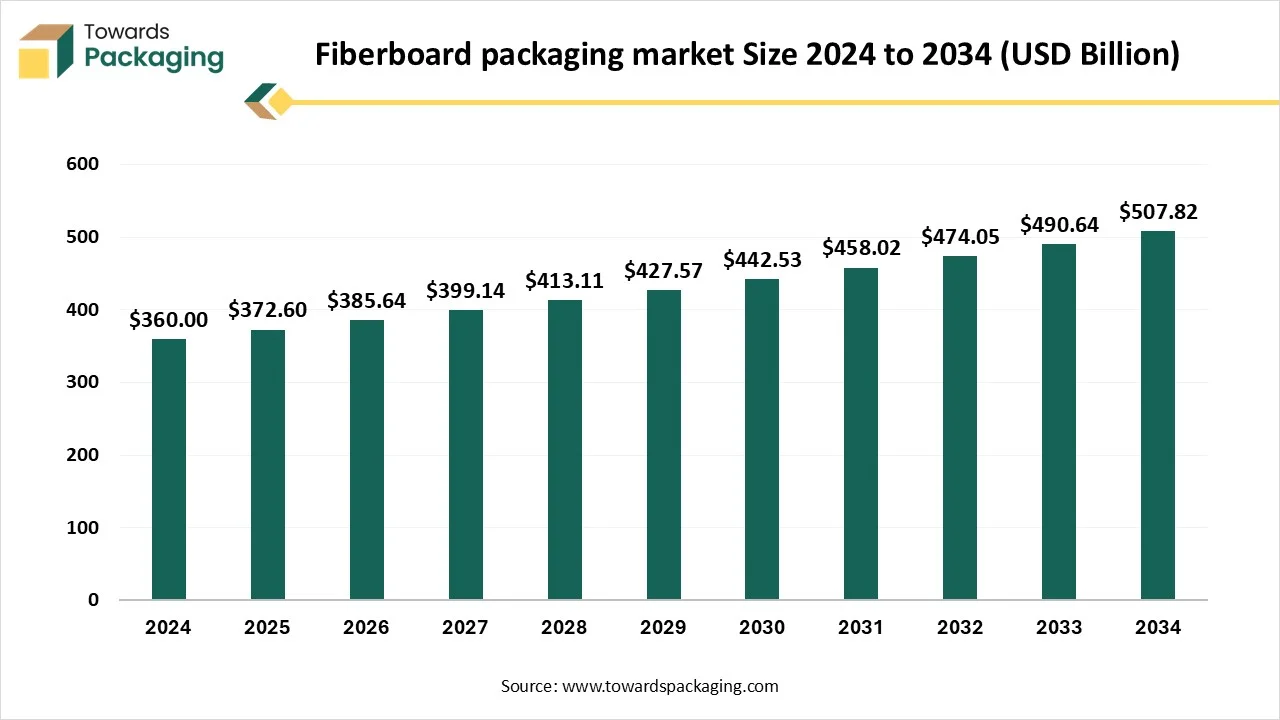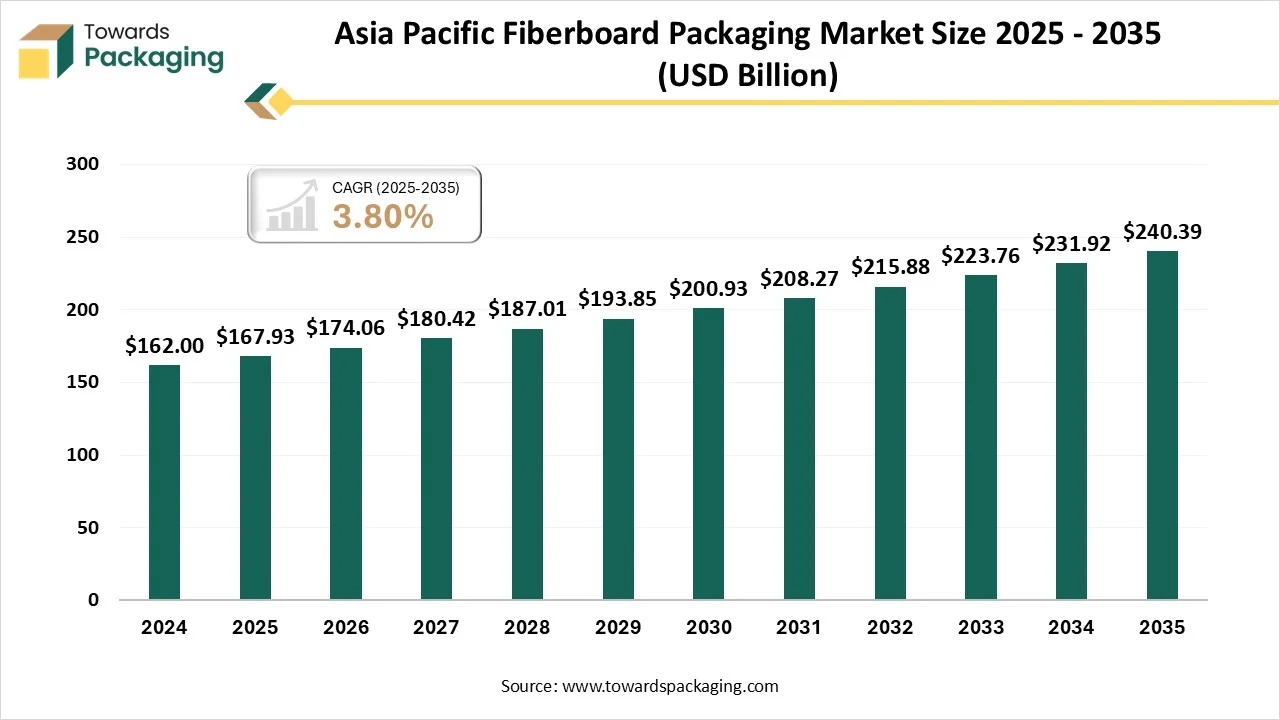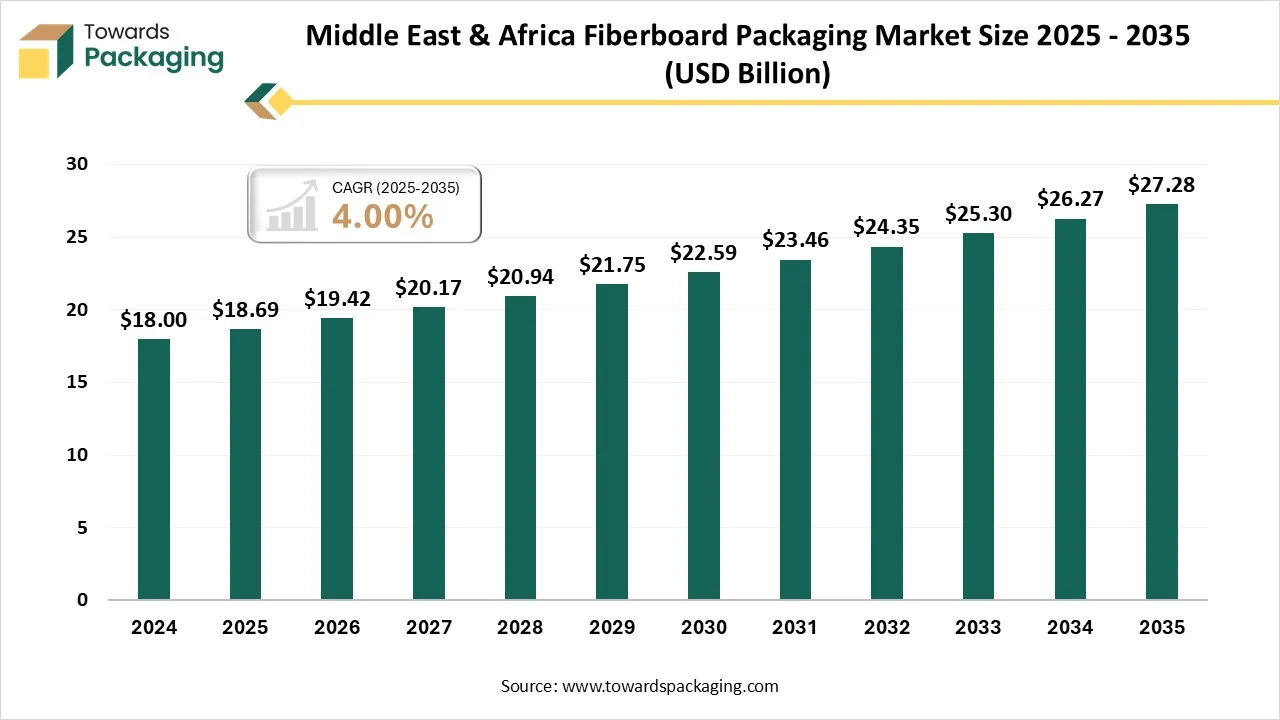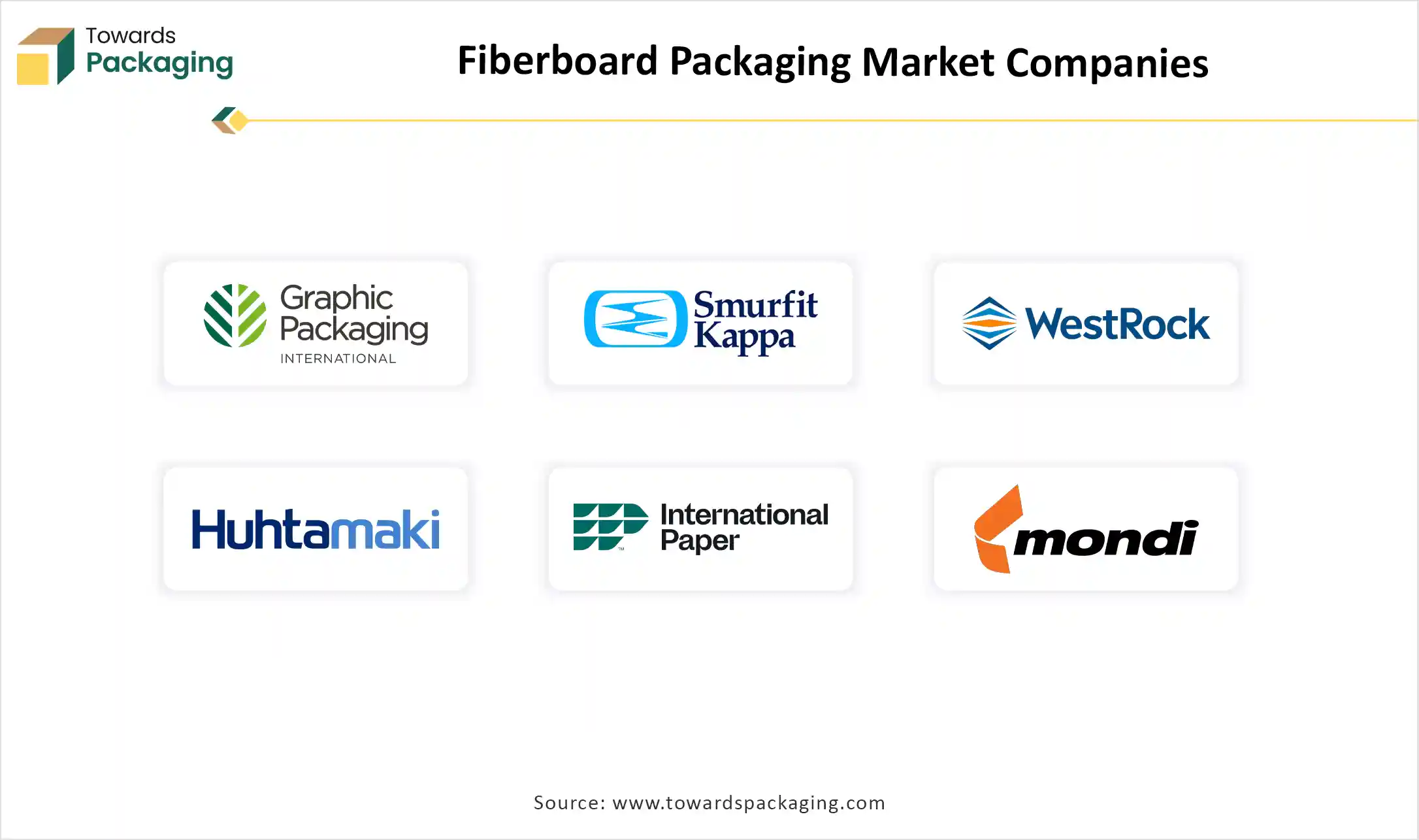The fiberboard packaging market is projected to reach USD 525.59 billion by 2035, expanding from USD 385.64 billion in 2026, at an annual growth rate of 3.5% during the forecast period from 2026 to 2035. Growing demand is driven by e-commerce penetration, rising focus on eco-friendly packaging, and regulatory support for sustainable materials. End users range from logistics and retail to healthcare and electronics industries, with the Asia Pacific dominating due to large-scale manufacturing and booming export activity.

The fiberboard packaging market refers to the production and use of packaging materials made from fiberboard, a derivative of wood pulp that includes corrugated fiberboard, solid fiberboard, and composite structures. Widely adopted across food & beverage, consumer goods, e-commerce, and industrial applications, fiberboard packaging provides strength, flexibility, and recyclability, making it a sustainable alternative to plastics. Its lightweight structure lowers transportation costs, while customization options such as printing and lamination enhance brand visibility.
| Metric | Details |
| Market Size in 2025 | USD 372.6 Billion |
| Projected Market Size in 2034 | USD 507.82 Billion |
| CAGR (2025 - 2034) | 3.5% |
| Leading Region | Asia Pacific |
| Market Segmentation | By Product Type, By Grade, By Packaging Type, By Application, By End User and By Region |
| Top Key Players | Graphic Packaging International, Smurfit Kappa Group plc, WestRock Company, International Paper Company, Mondi Group, DS Smith plc, Packaging Corporation of America (PCA), Nine Dragons |
Benefits Drives The Fiberboard Packaging Market
Fiberboard packaging is the most cost-effective packaging selection since it lowers the usage while lowering the waste. Lower machinery and labor costs are assisted by lower raw material prices and the potential for huge production. This kind of material is prevalently used for anything from transportation to packaging and is conveniently made available. They are heavily used in retail foundations to display materials to ship the containers while being cost-effective at the same time. They are transferring boxes, and warehouse solutions are instances of how it is used at home.
The advantages of corrugated cardboard are several, as they are the possibilities it serves. This material plays an important role in every aspect of your items, from delivery to buying. Corrugated fiberboard is the most economical and environmentally friendly option for your packaging, preventing goods from being damaged while also sending a strong message about the perfect suitability of this planet.
Natural Factors Affect Fiberboard Packaging
Corrugated boxes can be impacted by the condition. They are not at all water-resistant, which means snow or rain can easily damage them. This is the big issue if anyone transports or keeps items outside. These types of boxes can track normal shipping loads but are not rigid under heavy pressure. This could cause them to crumble or fall. It's important to analyze if your items are too heavy for these boxes. Corrugated boxes are not reusable, just like plastic or metal. These points that one demands to buy more frequently can increase costs. Businesses might appear for other choices that can be used several times.
Main Ingredient Are The Upcoming Growth In Fiberboard Packaging Market
Wood Pulp is the key material used in the making of the corrugated packaging that can be produced from used newspapers and leftover substances from different sectors. The fact that these boxes are being made from recycled materials, which are hig0hly eco-friendly and are a reliable option for any organisation. Producers of this packaging can reuse their residual waste to develop unique boxes. As wood pulp is the organic integration of the corrugated boxes, it is conveniently decomposed when exposed to oxygen and moisture in the surrounding environment.
The procedure of its decomposition generally takes fewer days to complete, and the perfect space is where less toxin is generated during this period. This biodegradable nature makes them the best option for the ecosystem as compared to plastic packaging. Furthermore, the pivotal reason for ocean acidification is the sector that regularly releases its waste into these water bodies. Its outcomes in lowering the carbonate make the survival of marine organisms challenging. So, the accurate solution to tackle this problem is to increase the usage of corrugated fiberboard boxes.
VTT Technical Research Centre of Finland, in partnership with Finnish industrial partners and Aalto University has created the latest technology for making the cardboard in a different continuous procedure to make reel–to-reel origami -inspired patterns and designs for fibre-based packaging materials.
Research and development and invention are the main drivers for development in the packaging and paper sector, particularly given the worldwide concentration on sustainability and a movement to green materials. Feedbacks believe that generative AI can surely develop the Research and Development productivity by helping every stage of the R&D life cycle, assisting organisations in making the latest ideas with the help of intellectual property (IP) and patient analysis, serving customer analysis, making personalization options, growing the idea-to-imagine procedure, and optimizing field-testing response.
The corrugated-single wall segment dominated the fiberboard packaging in 2024, as single-wall corrugated boxes are one of the most prevalent kinds of packaging utilised in industries globally. These boxes have a single layer of fluted paper, which is placed between two flat linerboards. The pattern delivers the boxes a lightweight pattern while serving enough power for carrying and transporting different products. Single-wall boxes are specifically used for the transportation of non-sensitive items that do not need full security. Instances of items generally packaged in single-wall corrugated boxes include books, clothing, non-breakable items, and small electronics, too. They serve as a cost-effective and smooth solution for general storage and shipping.
The corrugated double-wall segment is predicted to be the fastest in the market during the forecast period. Double-wall corrugated fiberboard boxes are a rigid, more reliable alternative to single-wall containers, which are crafted for bulkier, heavier, and more sensitive products. These boxes consist of two surfaces of fluted paper classified by the three linerboards. The extra fluted surface in a double-wall box develops its power, serving superior protection against external pressure that affects the rough handling. The double-wall construction serves the main platform when it comes to a huge transit period, more frequent carrying, or adaptation to changing surrounding conditions.
The recycled fiberboard-testliner segment has dominated the fiberboard packaging market in 2024, as testliners are strips of fiberboard that are assembled to make the cells or compartments within a box. These cells are utilised to classify and prevent individual items during shipping, such as glass containers, sensitive items, and bottles. By protecting products from meeting, each other, the recycled fiberboard testliners assist in lowering the risk of damage during logistics and transportation. They are important in ensuring that products arrive at their destination undamaged and intact, too.
The virgin paperboard -kraft paper segment is predicted to be the fastest-growing in the market during the forecast period. Kraft paper boxes are produced from kraft paper, which is a paperboard generated by the chemical pulping procedure known as the "kraft process”. This generates the unbleached and rigid yet eco-friendly packaging bulk, prevalently brown with an irregular pattern. They are 100% biodegradable, recyclable, and compostable. It's a natural wood pulp item that is not generally bleached or chemically refined, which makes it one of the most environmentally-friendly packaging materials.
The boxes and cartons-slotted boxes segment dominated the market in 2024 as cardboard packaging points to packaging boxes and materials created from a thick and strong type of paper, a dependent material known as cardboard. Cardboard is an evergreen and widely used packaging material because of its strength, durability, and affordability. It is made of several layers of paper fibers, which are compressed together to make a strong and sturdy pattern and structure. As it comes in different forms, including cartons, boxes, inserts, and trays, it can be conveniently folded, cut, and shaped into various designs and sizes to suit particular packaging demands.
The carton box or cardboard box is a necessary packaging created from a single sheet of either corrugated fiberboard or paperboard. Carton boxes are utilised for packaging, which delivers goods to materials. Carton boxes are created from recycled paper, to make it strong, which is placed between two liners. The liners are generated by pressing moist fibers together from rags or wood and even grasses, which then dry to make flexible sheets.
The folding cartons segment is expected to be the fastest in the market during the forecast period. The folding carton packaging is created from paperboard and is crafted to be shaped. It is a famous selection for packaging suitable goods, pharmaceuticals, and food, too. Specifically, it is a lightweight yet reliable enough item during shipping and storage, too. Just like rigid boxes, folding cartons should be sealed, which lowers the storage and shipping costs, too. Folding cartons serve as a cost-effective solution for organisations that demand both affordability and quality. Since they are created from paperboard, they are usually less costly than strong packaging selections. Furthermore, folding carton packaging is generally tailored, allowing businesses to align with packaging for their brand touch, having printed designs, logos, and eco-friendly selections.
The food and beverage segment dominated the fiberboard packaging in 2024, as fiberboard is a versatile kind of protective packaging material. Their request stems from the fact that they are compostable, biodegradable, and recyclable. They are convenient to brand and personalise into various shapes and sizes, ensuring easy handling, transportation, and storage. Unfortunately, cardboard and paper don’t serve the same reliability, impact prevention, and transportation and storage as the other protective packaging materials. Initially, it came from renewable wood fibers; fiberboard is biodegradable and recyclable, as it serves branding possibilities and different designs, which are compatible with different shapes and finishes.
The E-commerce and retail segment is expected to be the fastest in the market during the forecast period. Corrugated cardboard boxes are the ideal choice for much of the sector. Cardboard is rigid, which does not require pouring the package’s weight, and is recyclable. For every sensitive or bulky product, double-walled cardboard serves retailers with an extra layer of power and protection. In some scenarios, items come in their own box, which is perfect for transportation. On the other hand, fiberboard packaging is created from surfaces of recycled paper, making it strong and lightweight. This means it is optimal for retail supply chains, serving reliable corrugated packaging options which protect products and lower the overall shipping costs too.
The manufacturers segment has dominated the fiberboard packaging market in 2024 as Chemist Carl F. Dahl created the procedure of pulping wood, which was later utilized in the paper-making development. So a pulp mill is a manufacturing facility that generally uses large-scale processes to transform woodchips, timber, and other wood products into pulp using the kraft process. Then the fibres from any tree or plant can be utilised to make paper; hence, the power and quality of these fibers change among tree varieties.
So the goal of the pulping procedure is to classify the pattern of the fibre source into the fibres that are ready to be created into industrial pulp. Also, the filler supplies, such as clays and chalks, can be added, which encourages the complexity of the outcome product. Scaling, such as rosins, starch, and gums, can also be added at this platform, and ranging will affect the path ink feedback with the paper; the selection of evaluation is dependent upon the demanding usage of the paper.
The e-commerce companies segment are predicted to be the fastest-growing in the market during the forecast period. Several e-commerce stages transport millions of packages daily and depend on corrugated boxes for packaging. And the reason after this is that the corrugated boxes serve the ideal balance between cost-efficiency and reliability. The usage of corrugated boxes also creates a smooth workflow, along with gaining user commitment.
Also, the latest state of the corrugated boxes, particularly in the e-commerce scenario, is going perfectly, as they are transforming the go-to option for many brands for their items, in terms of storage and transportation. Their even patterns are cutting-edge, as they serve as a wanted extra layer for the product's security above all, as they are environmentally friendly, which means they are recyclable as well.

Asia Pacific dominated the fiberboard packaging market in 2024, as fiberboard packaging in recent years is all about the presentation, smoothness, personalization, and sustainability, which are crucial priorities. As trends such as fit-to-product automated packaging solutions, advanced level digital printing, and retail-ready packaging gain attention, organizations investing in these services will be perfect, which are tracked to align with customer costs, retailer demands, and lower the negative surrounding impact.
As these inventions update the fiberboard sector, operating with a packaging partner that experiences growing technologies will serve as a competitive edge.
North America is predicted to be the fastest-growing in the market during the forecast period. In this region, fiberboard packaging is witnessing constant growth, driven by sustainability urges, regulatory pressure, and the bottom of e-commerce. Brands and retailers are moving towards molded fiber and fiberboard solutions as environmentally friendly alternatives to plastics, giving importance to recyclability and greater recycled content, too. Fiberboard packaging stays dominant for logistics and shipping, while molded fiber packaging is stretching in electronics, foodservice, and cosmetics due to its biodegradability and protective qualities, too.
UFP packaging is a loyal corrugated (fiberboard ) producer in Texas, Indiana, and soon in the Western United States, which generates different cost-effective packaging for cardboard solutions, including point-of-purchase displays, stock corrugated boxes, retail-ready packaging, and custom four-colour die-cutting packaging, and e-commerce shippers too.


Tier 1
Tier 2
Tier 3
By Product Type
By Grade
By Packaging Type
By Application
By End User
By Region
December 2025
December 2025
December 2025
December 2025